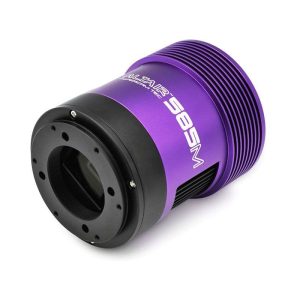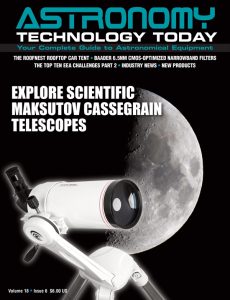The Altair 585M Mono Cooled Camera is a high-performance astrophotography camera designed for deep-sky, planetary, and lunar imaging. Featuring the Sony IMX585 monochrome sensor, it offers exceptional sensitivity, low noise, and a wide dynamic range, making it an excellent choice for capturing fine details in celestial objects.
 While its mono sensor requires the use of filters for color imaging, it has the capability to provide greater flexibility and sensitivity compared to color cameras. Whether for deep-sky astrophotography, high-resolution planetary imaging, or electronically assisted astronomy, the Altair 585M Mono Cooled Camera is a powerful tool for capturing the cosmos with precision and clarity.
While its mono sensor requires the use of filters for color imaging, it has the capability to provide greater flexibility and sensitivity compared to color cameras. Whether for deep-sky astrophotography, high-resolution planetary imaging, or electronically assisted astronomy, the Altair 585M Mono Cooled Camera is a powerful tool for capturing the cosmos with precision and clarity.
The Altair 585M Mono Cooled Camera uses the latest Starvis 2 BSI sensor, with a high frame rate, no amp glow and very high sensitivity. Sony Starvis 2 improves on version 1 with better dynamic range and sensitivity in the red regions of the spectrum, including H-Alpha. Peak Quantum Efficiency is about 91%.
The sensor has a 12.84mmm diagonal and 2.9um pixels and is well-suited for deep-sky imaging with a wide field refractor such as the Altair 60EDF, which has a 288mm focal length with its F4.8 reducer.
Its thermoelectric cooling (TEC) system reduces thermal noise by cooling the sensor up to -35°C below ambient temperature, allowing for long-exposure deep-sky imaging with improved signal-to-noise ratio. The high quantum efficiency (QE) of the mono sensor enhances its ability to capture faint details, making it ideal for use with LRGB and narrowband filters for high-contrast astrophotography.
With a resolution of 3840 x 2160 (8.3 megapixels) and a 1/1.2” sensor size, the 585M provides a wide field of view while maintaining fine pixel detail for smooth real-time imaging and high-speed video capture for planetary and lunar photography. Its low read noise and 14-bit ADC ensure clean, high-contrast images with smooth tonal transitions. The adjustable gain and exposure settings allow users to optimize the camera for various imaging conditions, from bright planetary surfaces to faint deep-sky nebulae.
Although it is a USB3.0 camera, it’s also fully compatible with USB2.0 ports when a longer cable and less speed are required, for example in deep-sky or video astronomy using the live stacking features in AltairCapture or Sharpcap.
The camera has an ST4 auto-guiding port and can be used to auto-guide with mounts from all the major manufacturers supporting ST4 format, including iOptron, Celestron and Skywatcher. The sensor is more than sensitive enough for autoguiding.
The 585M Mono Cooled Camera is fully compatible with popular astronomy software, including SharpCap, NINA, PHD2, and ASCOM drivers, ensuring seamless integration with existing astrophotography setups. It also works well with filter wheels, autoguiders, and motorized focusers, making it a versatile choice for advanced imaging configurations.
The Altair 585M Mono Cooled Camera features include:
– TEC cooling with heatsink for extra low noise
– On board temperature sensor for perfect dark frame calibration.
– 5A 12v DC Power supply included, with 110-240v input.
– IMX585 Mono 8.3mp Starvis 2 Back Illuminated CMOS Sensor
– On-chip HGC, LCG and HDR Support
– 3840 x 2160 pixel resolution
– 2.9 um Square Pixels
– 1/1.2-inch Optical Format
– 11.14 x 6.26 mm (12.85mm Diagonal) Sensor
– 12-bit ADC (with 16bit output in HDR mode)
– 512Mbyte DDR3 Memory buffer
– Low Noise with 0.65 to 0.5e- in HCG mode
– Fast Frame Rate 47 FPS in 8bit mode
– Binning from 1×1 to 8×8 in either stacking or averaging modes.
You can learn more about the Altair 585M Mono Cooled Camera here.
 And to make it easier for you to get the most extensive news, articles and reviews that are only available in the magazine pages of Astronomy Technology Today, we are offering a 1-year magazine subscription for only $6! Or, for an even better deal, we are offering 2 years for only $9. Click here to get these deals which only will be available for a very limited time. You can also check out a free sample issue here.
And to make it easier for you to get the most extensive news, articles and reviews that are only available in the magazine pages of Astronomy Technology Today, we are offering a 1-year magazine subscription for only $6! Or, for an even better deal, we are offering 2 years for only $9. Click here to get these deals which only will be available for a very limited time. You can also check out a free sample issue here.

